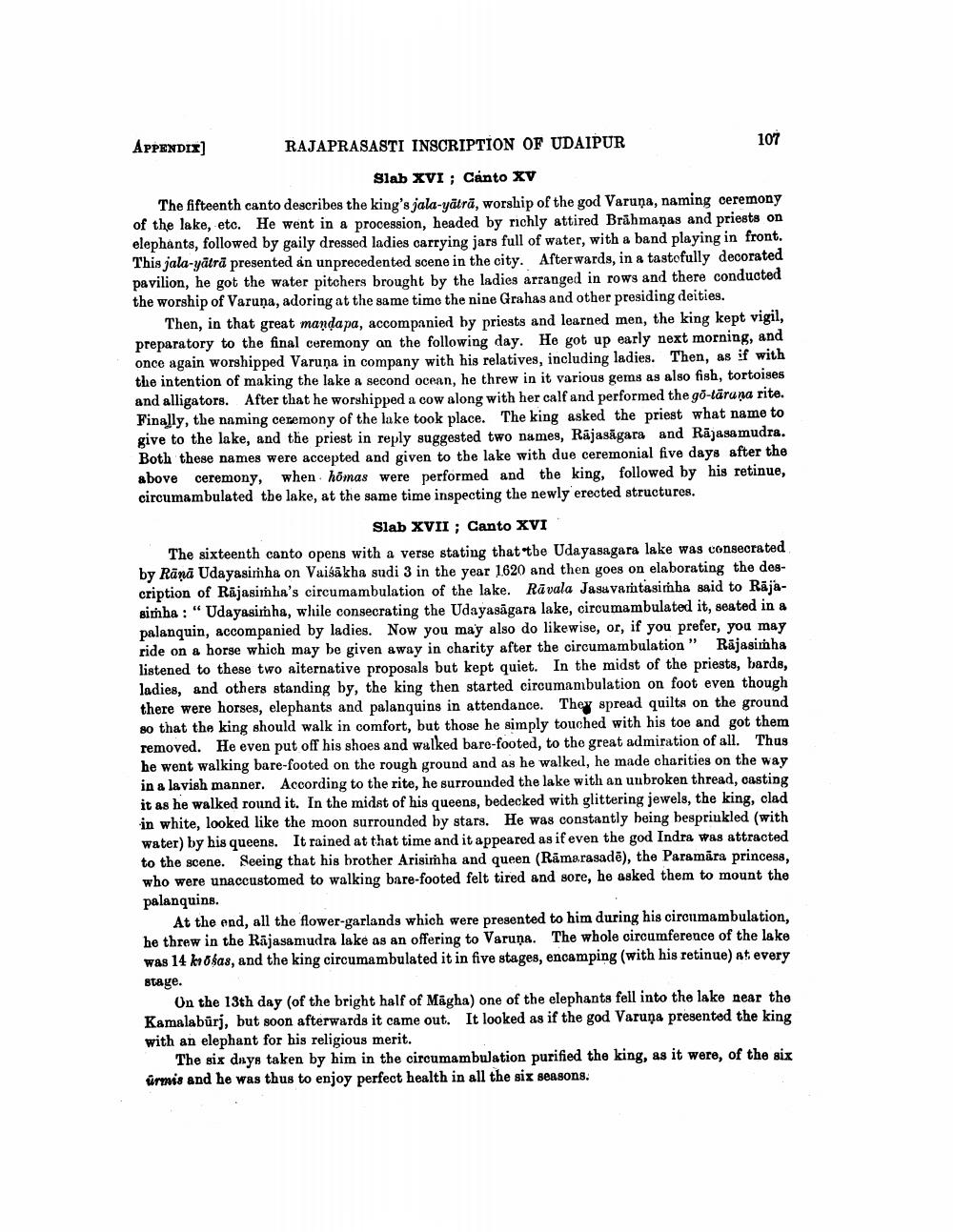________________
APPENDIX]
RAJAPRASASTI INSCRIPTION OF UDAIPUR
107
Slab XVI ; Cánto XV The fifteenth canto describes the king's jala-yātrā, worship of the god Varuna, naming ceremony of the lake, etc. He went in a procession, headed by richly attired Brāhmaṇas and priests on elephants, followed by gaily dressed ladies carrying jars full of water, with a band playing in front. This jala-yātrā presented an unprecedented scene in the city. Afterwards, in a tastefully decorated pavilion, he got the water pitchers brought by the ladies arranged in rows and there conducted the worship of Varuna, adoring at the same time the nine Grahas and other presiding deities.
Then, in that great mandapa, accompanied by priests and learned men, the king kept vigil, preparatory to the final ceremony on the following day. He got up early next morning, and once again worshipped Varuņa in company with his relatives, including ladies. Then, as if with the intention of making the lake a second ocean, he threw in it various gems as also fish, tortoises and alligators. After that he worshipped a cow along with her calf and performed the go-lāruņa rite. Finally, the naming ceremony of the lake took place. The king asked the priest what name to give to the lake, and the priest in reply suggested two names, Rājasāgara and Rājasamudra. Both these names were accepted and given to the lake with due ceremonial five days after the above ceremony, when homas were performed and the king, followed by his retinue, circumambulated the lake, at the same time inspecting the newly erected structures.
Slab XVII; Canto XVI The sixteenth canto opens with a verse stating that tbe Udayasagara lake was consecrated by Rāņā Udayasimha on Vaisakha sudi 3 in the year 1620 and then goes on elaborating the degcription of Rājasinha's circumambulation of the lake. Rāvala Jasuvamtasimha said to Rajasimba: "Udayasimha, while consecrating the Udayasāgara lake, cirou mambulated it, seated in a palanquin, accompanied by ladies. Now you may also do likewise, or, if you prefer, you may ride on a horse which may be given away in charity after the circumambulation ” Rājasimha listened to these two alternative proposals but kept quiet. In the midst of the priests, bards, ladies, and others standing by, the king then started circumambulation on foot even though there were horses, elephants and palanquins in attendance. They spread quilts on the ground 80 that the king should walk in comfort, but those he simply touched with his toe and got them removed. He even put off his shoes and walked bare-footed, to the great admiration of all. Thus he went walking bare-footed on the rough ground and as he walkeil, he made charities on the way in a lavish manner. According to the rite, he surrounded the lake with an unbroken thread, casting it as he walked round it. In the midst of his queens, bedecked with glittering jewels, the king, clad in white, looked like the moon surrounded by stars. He was constantly being besprinkled (with water) by his queens. It rained at that time and it appeared as if even the god Indra was attracted to the scene. Seeing that his brother Arisimha and queen (Rāmarasadē), the Paramara princess, who were unaccustomed to walking bare-footed felt tired and sore, he asked them to mount the palanquins.
At the end, all the flower-garlands which were presented to him during his circumambulation, he threw in the Rājasamudra lake as an offering to Varuņa. The whole circumference of the lake was 14 kn osas, and the king circumambulated it in five stages, encamping (with his retinue) at every stage.
On the 13th day of the bright half of Magha) one of the elephants fell into the lake near the Kamalabūry, but soon afterwards it came out. It looked as if the god Varuna presented the king with an elephant for his religious merit.
The six dnye taken by him in the circumambulation purified the king, as it were, of the six ürmis and he was thus to enjoy perfect health in all the six seasons.




